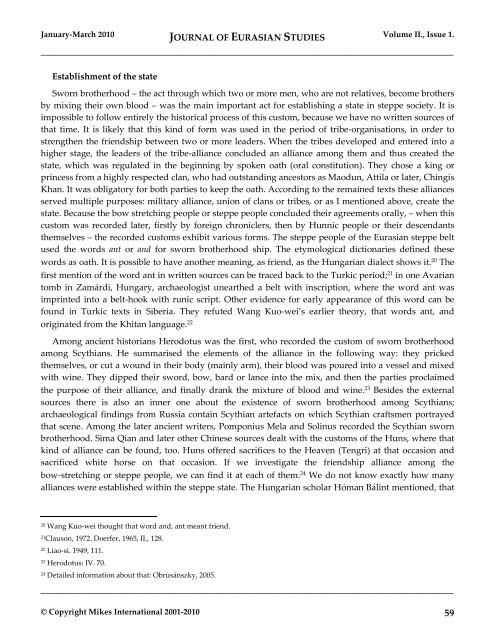EurasianStudies_0110..
EurasianStudies_0110..
EurasianStudies_0110..
Create successful ePaper yourself
Turn your PDF publications into a flip-book with our unique Google optimized e-Paper software.
January-March 2010 JOURNAL OF EURASIAN STUDIES Volume II., Issue 1.<br />
_____________________________________________________________________________________<br />
Establishment of the state<br />
Sworn brotherhood – the act through which two or more men, who are not relatives, become brothers<br />
by mixing their own blood – was the main important act for establishing a state in steppe society. It is<br />
impossible to follow entirely the historical process of this custom, because we have no written sources of<br />
that time. It is likely that this kind of form was used in the period of tribe-organisations, in order to<br />
strengthen the friendship between two or more leaders. When the tribes developed and entered into a<br />
higher stage, the leaders of the tribe-alliance concluded an alliance among them and thus created the<br />
state, which was regulated in the beginning by spoken oath (oral constitution). They chose a king or<br />
princess from a highly respected clan, who had outstanding ancestors as Maodun, Attila or later, Chingis<br />
Khan. It was obligatory for both parties to keep the oath. According to the remained texts these alliances<br />
served multiple purposes: military alliance, union of clans or tribes, or as I mentioned above, create the<br />
state. Because the bow stretching people or steppe people concluded their agreements orally, – when this<br />
custom was recorded later, firstly by foreign chroniclers, then by Hunnic people or their descendants<br />
themselves – the recorded customs exhibit various forms. The steppe people of the Eurasian steppe belt<br />
used the words ant or and for sworn brotherhood ship. The etymological dictionaries defined these<br />
words as oath. It is possible to have another meaning, as friend, as the Hungarian dialect shows it. 20 The<br />
first mention of the word ant in written sources can be traced back to the Turkic period; 21 in one Avarian<br />
tomb in Zamárdi, Hungary, archaeologist unearthed a belt with inscription, where the word ant was<br />
imprinted into a belt-hook with runic script. Other evidence for early appearance of this word can be<br />
found in Turkic texts in Siberia. They refuted Wang Kuo-wei’s earlier theory, that words ant, and<br />
originated from the Khitan language. 22<br />
Among ancient historians Herodotus was the first, who recorded the custom of sworn brotherhood<br />
among Scythians. He summarised the elements of the alliance in the following way: they pricked<br />
themselves, or cut a wound in their body (mainly arm), their blood was poured into a vessel and mixed<br />
with wine. They dipped their sword, bow, bard or lance into the mix, and then the parties proclaimed<br />
the purpose of their alliance, and finally drank the mixture of blood and wine. 23 Besides the external<br />
sources there is also an inner one about the existence of sworn brotherhood among Scythians;<br />
archaeological findings from Russia contain Scythian artefacts on which Scythian craftsmen portrayed<br />
that scene. Among the later ancient writers, Pomponius Mela and Solinus recorded the Scythian sworn<br />
brotherhood. Sima Qian and later other Chinese sources dealt with the customs of the Huns, where that<br />
kind of alliance can be found, too. Huns offered sacrifices to the Heaven (Tengri) at that occasion and<br />
sacrificed white horse on that occasion. If we investigate the friendship alliance among the<br />
bow-stretching or steppe people, we can find it at each of them. 24 We do not know exactly how many<br />
alliances were established within the steppe state. The Hungarian scholar Hóman Bálint mentioned, that<br />
20 Wang Kuo-wei thought that word and, ant meant friend.<br />
21 Clauson, 1972. Doerfer, 1965, II., 128.<br />
22 Liao-si. 1949, 111.<br />
23 Herodotus: IV. 70.<br />
24 Detailed information about that: Obrusánszky, 2005.<br />
_____________________________________________________________________________________<br />
© Copyright Mikes International 2001-2010 59

















